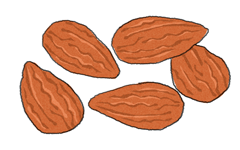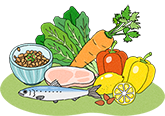Vitamin E

Vitamin E is one of the fat-soluble vitamins. Its main physiological effect is due to its antioxidant properties, and it helps to perform the very important function of protecting the body's cellular membranes from oxidative damage. Foods rich in vitamin E include nuts and plant-based oils. Examples of everyday food items rich in vitamin E include almonds, safflower oil, and rapeseed oil.
Natural vitamin E is a d-α-tocopherol and a d-isomer.
Synthetic vitamin E is a dl-α-tocopherol dl-isomer.
Dl-isomer vitamin E is a synthetic version which contains equal amounts of α-tocopherol isomers in a symmetric fashion in its chemical formula.
Vitamin-E is a fat soluble vitamin but does not contain any fat itself and, therefore, will not cause a person to gain weight through its ingestion alone.
Vitamin E functions as a fat-soluble anti-oxidizing agent in the body and can help to prevent oxidation by polyunsaturated fatty acids (PUFA).
This mechanism works in the same way both within food and inside the body. Essentially, the vitamin protects against oxidation caused by unstable molecules. PUFAs oxidize more easily with an increase in double bonds, and this can cause the body to require more vitamin E than usual. Therefore, vitamin E requirements rise steadily with the ingestion of linoleic acid (two double bonds) to linolenic acid (three double bonds) and even more so for the recently popular EPA (five double bonds) and DHA (six double bonds) fatty acids. As a general rule, we can assume that the difference between two and three double bonds is approximately twofold, and the difference between three and four double bonds is approximately twofold as well. Many of these PUFAs exist in phospholipid layers such as biological membranes and lipoproteins, and protection against oxidation in these areas is carried out by the vitamin E within these membranes. Therefore, when the amount of PUFAs that a person ingests through food increases, their vitamin E requirements increase as well.
Because of this phenomenon, an excess intake of PUFAs can possibly lead to vitamin E deficiency. Some examples of common food sources of vitamin E include polyunsaturated oils (cottonseed oil, safflower oil, etc.), nuts (almonds, hazelnuts, etc.), and brightly colored vegetables high in β-carotene (pumpkin, spinach, etc.).
Polyunsaturated fatty acids are naturally vulnerable to oxidation. Because we know that the degeneration of these substances into oxidants can be harmful to the walls of the blood vessels and can lead to arteriosclerosis (hardening of the arteries) and other health problems, it is a common recommendation to take vitamins with anti-oxidizing properties such as vitamin E and vitamin C as well when ingesting food with large amounts of PUFAs.
(Answer provided by Dr. Osamu Igarashi, Professor Emeritus, Ochanomizu University.)






